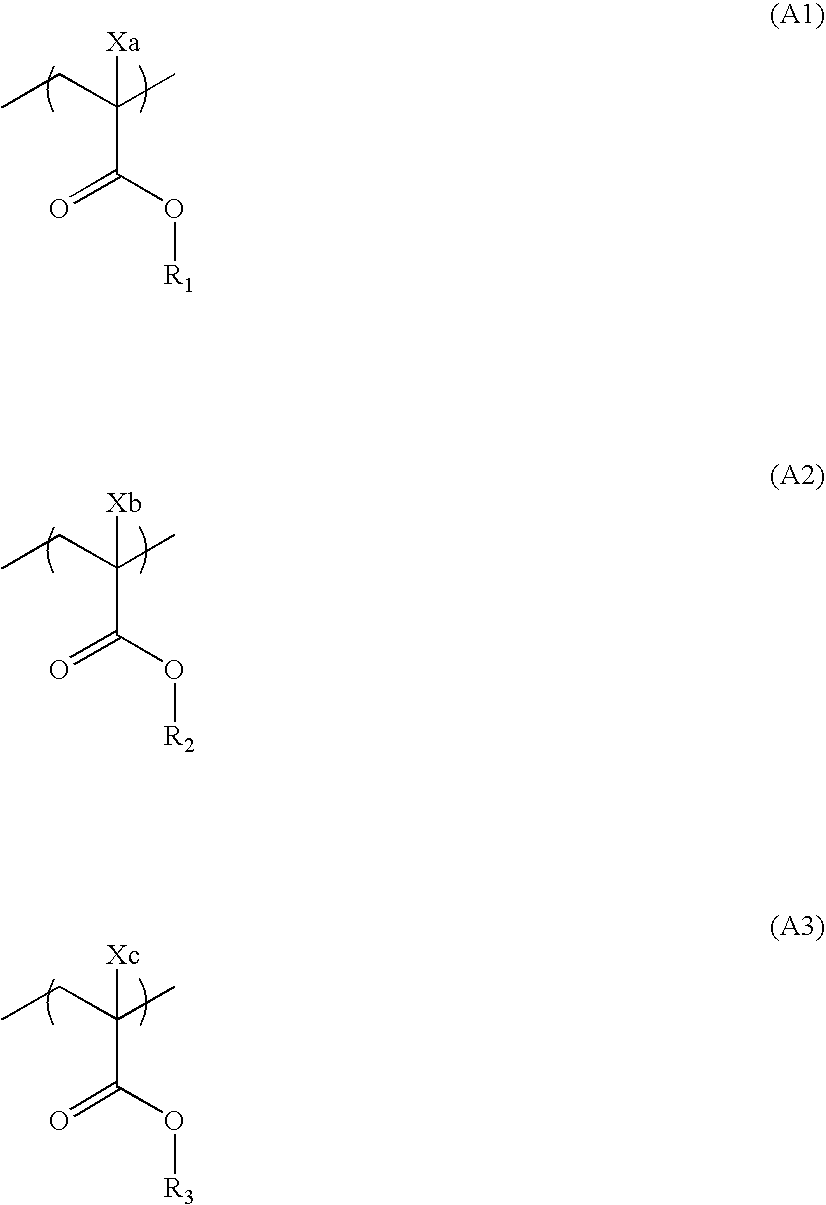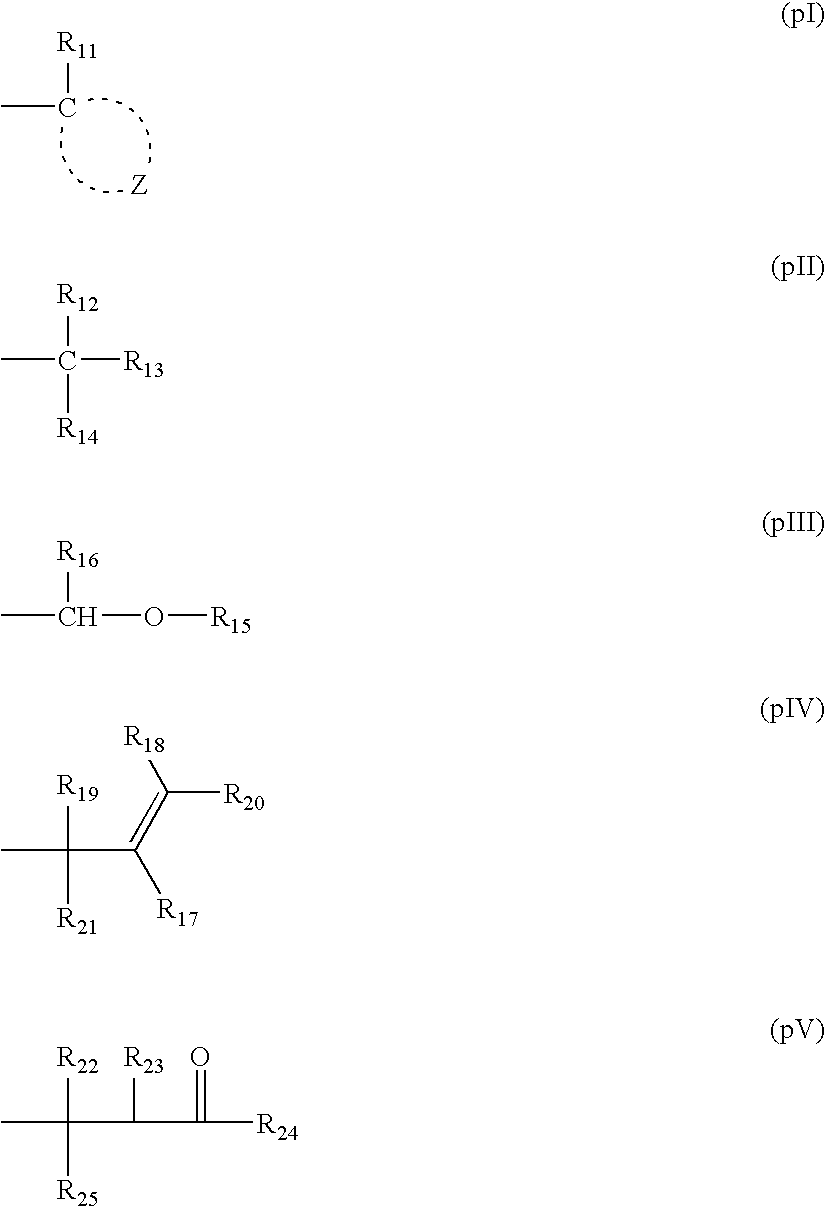Pattern forming method
a pattern and forming technology, applied in the field of pattern forming methods, can solve the problems of difficulty in stabilizing production costs and qualities of apparatus and materials, affecting the quality of resists, and unable to meet the requirements of immersion lithography,
- Summary
- Abstract
- Description
- Claims
- Application Information
AI Technical Summary
Benefits of technology
Problems solved by technology
Method used
Image
Examples
synthesis example 1
Syntheses of Resins (C-1) and (C-2)
[0361]3,5-Bis(1,1,1,3,3,3-hexafluoro-2-hydroxypropane-2-yl)cyclohexyl 2-trifluoromethylmethacrylate in an amount of 0.06 mole and (5-norbornene-2-methyl)-1,1,1,3,3,3-hexafluoropropane-2-ol in an amount of 0.04 mole were prepared, and mixed. This mixture was placed in an atmosphere of nitrogen and stirred at 80° C., and thereto 1.5 mole % of V-59, a polymerization initiator produced by Wako Pure Chemical Industries, Ltd., was added and stirred for additional 3 hours. Thereafter, the stirring was further continued for 12 hours while adding 1.5 mole % of the polymerization initiator V-59 at intervals of 3 hours. After completion of the reaction, the reaction solution (C-1) was dissolved in 20 mL of THF, and cooled to room temperature. The resulting solution was poured into 800 mL of hexane to result in precipitation of white powdery crystals. These crystals were filtered off, thereby collecting the intended resin (C-1) having the structure illustrated...
synthesis example 2
Synthesis of Resin (C-3)
[0364]Di-μ-chlorosyl-[(η-allyl)palladium(II)] in an amount of 0.262 g and silver antimonate in an amount of 0.488 g were dissolved in 44 mL of chlorobenzene, and stirred at room temperature. After a lapse of 20 minutes, the reaction mixture was filtered, and the filtrate was added to a mixture of 20 g of 5-norbornene-1,1,1,3,3,3-hexafluoropropane-2-ol, 0.2 mL of water and 170 mL of chlorobenzene. The resulting admixture was further stirred for 20 hours at room temperature, and poured into 1,200 mL of methanol. A resin thus precipitated was filtered off. The resin obtained was dissolved in 150 mL of chlorobenzene, and thereto 30 ml of methanol and 3.2 g of sodium boron hydride were added and stirred for 3 hours at room temperature. Further, the resulting reaction mixture was allowed to stand for 24 hours at room temperature. Pd(0) grains thus precipitated were filtered out, and the filtrate was poured into 800 mL of methanol. The thus precipitated resin was fi...
synthesis example 3
Syntheses of Resins (C-4) to (C-6)
[0366]1,1,1,3,3,3-Hexafluoro-2-(4-(1,1,1,3,3,3-hexafluoro-2-hydroxypropane-2-yl)cyclohexyl)propane-2-yl methacrylate in an amount of 20 g was dissolved in 70 mL of propylene glycol monomethyl ether acetate. To this solution, 3 mole % of a polymerization initiator V-601 produced by Wako Pure Chemical Industries, Ltd. was added. The resulting solution was added dropwise over a period of 6 hours to 10 ml of propylene glycol monomethyl ether acetate heated to 80° C. After conclusion of the addition, the reaction solution was stirred for 2 hours. The thus obtained reaction solution (C-4) was cooled to room temperature after completion of the reaction, and was poured into a 4.5-times amount of hexane to result in precipitation of white powdery crystals. These crystals were filtered off, thereby collecting the intended resin (C-4) having the structure illustrated hereinafter.
[0367]The weight-average molecular weight of Resin (C-4) was found to be 8,500 as ...
PUM
| Property | Measurement | Unit |
|---|---|---|
| wavelength | aaaaa | aaaaa |
| wavelengths | aaaaa | aaaaa |
| solubility | aaaaa | aaaaa |
Abstract
Description
Claims
Application Information
 Login to View More
Login to View More - R&D
- Intellectual Property
- Life Sciences
- Materials
- Tech Scout
- Unparalleled Data Quality
- Higher Quality Content
- 60% Fewer Hallucinations
Browse by: Latest US Patents, China's latest patents, Technical Efficacy Thesaurus, Application Domain, Technology Topic, Popular Technical Reports.
© 2025 PatSnap. All rights reserved.Legal|Privacy policy|Modern Slavery Act Transparency Statement|Sitemap|About US| Contact US: help@patsnap.com



